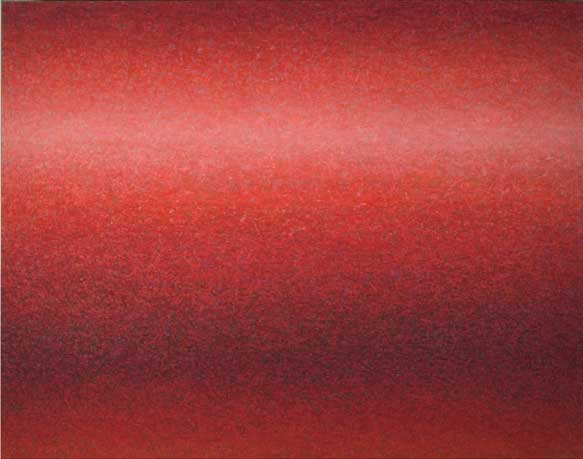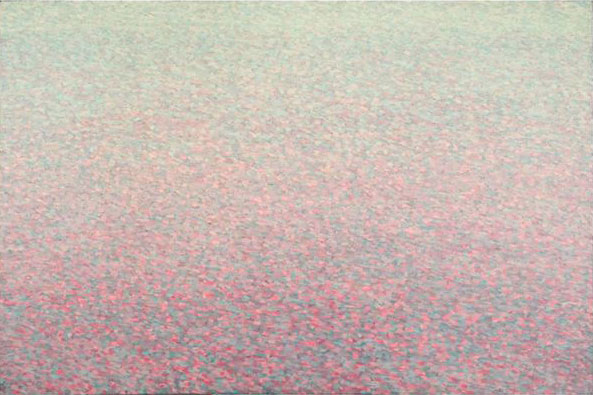Leonard Nelson (1912-1993)
Below, I define and show the origins of the “perceptual” manifestation of art. For argument’s sake, the perceptual came after realism and abstract expressionism in modern art history (realism>abstract expressionism>perceptual). It occupies the space between them whereby one is forced to decide what one sees. The great impressionists, such as Cezanne and Monet, may have tried to paint it at the ends of their careers, but they were limited by the complex of their painted subjects. Their starting point of realism made it difficult to achieve success. They may have envisioned it, cerebrally, but they couldn’t capture it on canvas. For example, starting with a portrait and breaking it apart to make it appear abstract led to an abstract portrait. There was nothing to contemplate, or to decide on. There was no perceptual outcome. Starting from a basis of abstract expressionism and moving back towards realism as Philadelphia painter Leonard Nelson did, achieved nirvana.

Untitled, by Leonard Nelson, 36 x 50 in, Oil on canvas, 1975
With Nelson’s paintings, viewers might see water, land, sky, or a combination. They’re not too abstract that one can’t see anything, nor too real that an image is obvious. They expose the middle ground requiring perception. They are to be interpreted which makes them important, evolutionary, to twentieth-century American art.
Just as interesting, one can see in untitled 1975 (above) and Alma Noon (below) the influences that great American field painters had on Leonard Nelson, for instance, Mark Rothko, an abstractionist that stacked luminous color bands on top of each other, and James Whistler, a realist who painted tonal harbor scenes. Nelson drew visibly from both, albeit, unintentionally. He discovered the next organic phase of the painted surface, one centered on the unknown, or what can be. It was through his gradation of colors, or tonality, that he would achieve it. He would break paths in 1974 with his invention, according to Sam Hunter, Princeton University, 2000, and then go on to paint hundreds of paintings.

Alma Noon, Leonard Nelson, 72 x 92 in, Oil on canvas, 1979
As a young painter in New York City showing at Betty Parsons alongside Jackson Pollock and Rothko, Nelson locked onto a single idea: to join land and sky into a single visual, or unit. For instance, untitled 1948:

Untitled, by Leonard Nelson, 20 x 24 in, Oil on canvas, 1948
In fact, he was the first abstract expressionist painter to move his painting style into realism. He predated Philip Guston. Some might call what he painted abstract impressionism, but this phrase pairs incompatible words devoid of any known artist movement. Others describe his style as color field. Color is Nelson’s hallmark, by all means, but color field is patently abstract. A new term had to be assigned to what he painted, because none properly described it. I offer the “perceptual,” the sensation that one experiences first from seeing his work.

Untitled, by Leonard Nelson, 32 x 36 in, Oil on canvas, circa 1950
In the 1960’s, Nelson progressed in style. In untitled 1962 and untitled 1963 (below), one can see him divide his canvases between land and sky, using color and horizontal brushstrokes to blur the lines, or physical transition. He didn’t at this time employ Whistler-like tonality to accomplish the same, though one can see the hint of it start to seep in. Note his darker foregrounds and lighter backgrounds.

Untitled 1962, by Leonard Nelson

Untitled 1963, by Leonard Nelson
As well in 1963, he painted One Million Lire (below). Some believe this to be his first mature “perceptual” painting. It shows his growing intensity of vision and emotional consciousness.

One Million Lire, by Leonard Nelson, 30 x 36 in, Oil on canvas, 1963
In 1968, Nelson painted Alma’s Garden (below). His brush strokes tightened, markedly, from his earlier paintings. A critical step forward in reaching his ultimate destination.

Alma's Garden, by Leonard Nelson, 49.75 x74 in, Oil on canvas, 1968
He steered closer to his arrival, by painting the sky throughout the painting untitled 1970:

Untitled, by Leonard Nelson, 30 x 36 in, Oil on canvas, 1970
In 1974, Nelson “arrived” with the painting untitled 1974-1975:

Untitled, by Leonard Nelson, 48.25 x 72.25 in, Oil on canvas, 1974-1975
It would draw-in nearby Philadelphia art professor-painters, overtime ushering in the novel and spectacular, “Philadelphia School of Art.”

He would then paint the infinite galaxy beyond Earth, in his Alma series, particularly, Alma Night:

Alma Night, by Leonard Nelson, 72 x 90 in, Oil on canvas, 1979
Nelson would breakout again with Alma’s Garden, 1980 (below). He was now painting in his glory for Alma was his wife.

Alma's Garden, by Leonard Nelson, 56 x 70 in, Oil on canvas, 1980
Critically in Alma’s Garden, 1980, Nelson added to his atmospheric canvas what he saw as “exciting and beautiful.” He now insisted that his paintings be both. He became a Modern Seurat while keeping his Rothko and Whistler foundations. He had the upbringing to do so. He brought forward what he learned from his student years spent at the Pennsylvania Academy of the Fine Arts and Barnes in the late 1930s, and the French impressionist masterpieces that hung just feet away. They would have a lasting impact on how he approached painting. It’s likely the reason he painted with a brush versus staining, the preferred choice of color field painters. He was fortunate to be an art student at this time, caught between the old and new. He would grow into an art fountain of youth that kept pouring over its ledge.
In 1982, Nelson painted some of his best work. For instance, Tender Is The Night, Bright Is The Day, and Spring:

Tender Is The Night, by Leonard Nelson, 70 x 60 in, Oil on canvas, 1982

Bright Is The Day, by Leonard Nelson, 70 x 60 in, Oil on canvas, 1982

Spring, by Leonard Nelson, 51 x 72 in, Oil on canvas, 1980, 1981, 1982
In 1984, Nelson broke paths again in stride. His exciting and beautiful focus fueled the masterwork, It’s A Beautiful World (below). Hunter wrote in his 2001 monograph, titled “Leonard Nelson,” that Nelson’s latter paintings sometimes evoke Van Gogh’s “transfigured skies.”

It's A Beautiful World, by Leonard Nelson, 56 x 56 in, Oil on canvas, 1984
Nelson would further his constantly evolving painting style. He is the Modern Monet in Beautiful Day and Berwyn:

Beautiful Day, by Leonard Nelson, 60 x 50 in, Oil on canvas, 1988-1989

Berwyn, by Leonard Nelson, 60 x 50 in, Oil on canvas, 1987-1988
In 2019, as observed by Jessica Bailey, a talented and bright painter from London, Nelson painted “energy light” on par with Van Gogh. She called him the “Modern Van Gogh” unaware of what Hunter wrote years before. It’s clear in untitled 1992-1993, painted before his death in 1993 at the age of 81 (below). He is the “Missing Link” (Renee Russo, MFA/MA, 2019).

Untitled, by Leonard Nelson, 52 x 50 in, Oil on canvas, 1992-1993
|